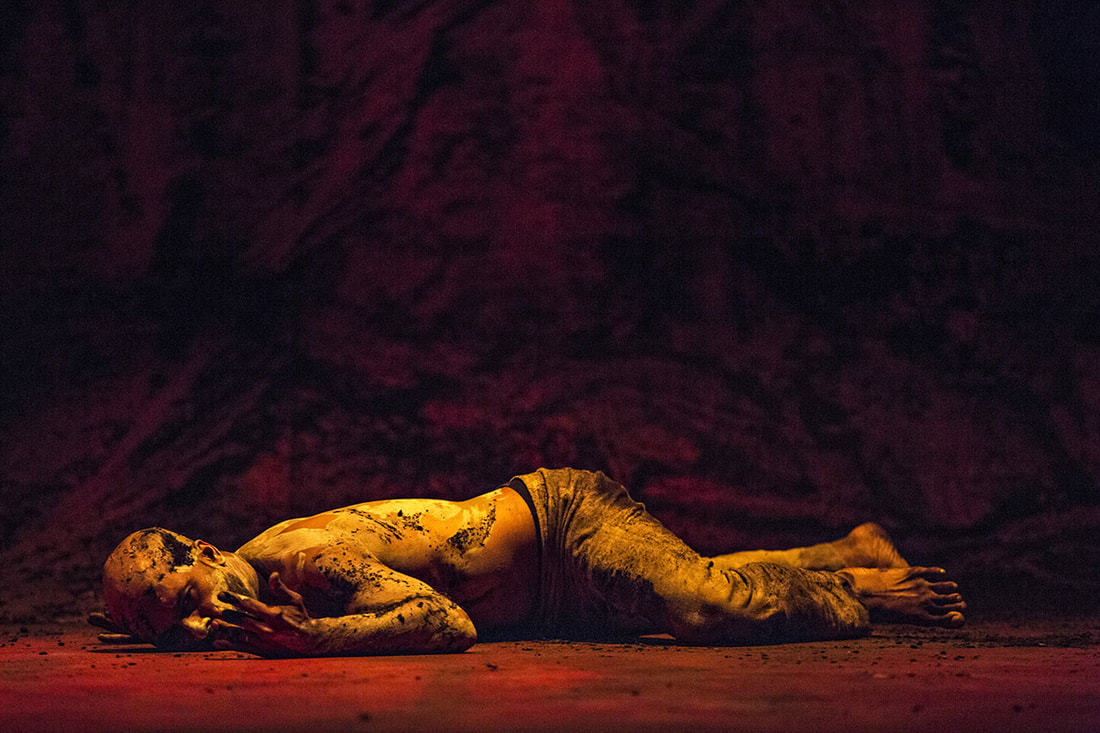|
Akram Khan performs in his latest and last solo, "Xenos." (DanceTabs) No dance artist can seize the imagination like Akram Khan. The dancer and choreographer startles his audience and then captures them, pulling them along on a journey that, in the case of “Xenos,” is both frightening and fascinating.
And though there were times, sitting the ’62 Center for Theatre and Dance at Williams College on Thursday, that I shook internally with fear at the unfolding of “Xenos,” I could not turn away. I was riveted every second by this Akram Khan Company production. In more than four decades of watching dance, I have not seen another solo that could do that – especially for more than an hour. “Xenos” is a powerful work. It’s intense and gritty, delving into the horrors war wrecks – mainly death and destruction, starvation and loneliness. Khan, along with his artistic and musical collaborators, created a blistering dystopia that haunts the mind well after the curtain comes down. As I write this now, I’m still tearing up. “Xenos” is beautifully crafted. The evening-length piece, inspired by the ordeal of a colonial Indian soldier during World War I, began before the audience settled in their seats. Percussionist BC Manjunath and vocalist Aditya Prakash were seated on pillows on stage performing Indian music. A string of bare light bulbs hung over them as sounds of bomb blasts crashed and lights flicked. But the two played and sang on, unfazed and numbed to war. Then Khan lumbered from the wings, struggling to tow a massive rope. He stumbled and fell on a small table that collapsed. As he struggled to regain his footing, the lights went black. Khan lit a match and we heard a voice from beyond say, “This is not war, this is the ending of the world.” Then, everything on stage, chairs, rugs, pillows, table, get drawn up and away, seemingly falling off of a cliff. Khan was alone, his only companion, a pile of dirt that he protected and nurtured – a precious and pathetic claim to territory that throughout the piece got scattered. This was his pilgrimage through the bloodshed. Khan, who combines Indian classical dance Kathak with contemporary dance, is a potent performer because of his honesty. As its creator, he is deeply invested in the work, which makes the audience invested too. When we heard the dogs barking, the reading of the names of the dead, the whistle that forced Khan to snap to attention or saw the chains that imprisoned his feet and hands, we too were shattered. The piece was built on these moments that continually sparked meaningful metaphors that resonate in today's unstable world. The dark and tense atmosphere was fed by the stellar creative team – dramaturg Ruth Little, playwright Jordan Tannahill, designer Mirella Weingarten, lighting designer Michael Hulls, costume designer Kimie Nakano and composer Vincenzo Lamagna whose music was played with intense focus by Manjunath and Prakash as well as bassist Nina Harries, violinist Clarice Rarity and saxophonist Tamar Osborn. I don’t usually list the full creative team, but “Xenos” is perfection. Obviously, its creators were devoted to the work, nurturing it to the pinnacle of its power. My only regret is that this is Khan’s last solo. While I weep over the years I did not see him dance, I’m grateful I saw him perform before he steps off the stage for good. I now look forward to what he creates in years to come. It’s no exaggeration to say, he’s one of the most important voices in dance today.
2 Comments
Leave a Reply. |
Wendy
|

 RSS Feed
RSS Feed
